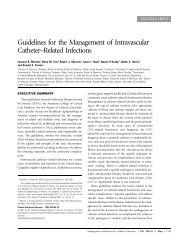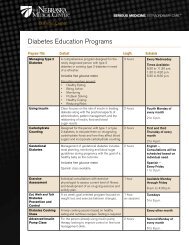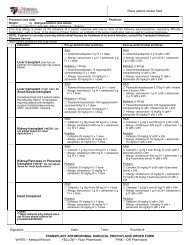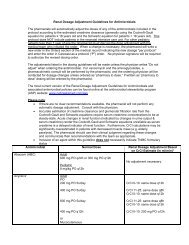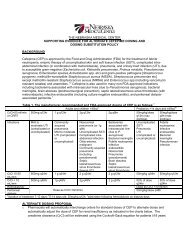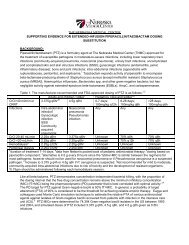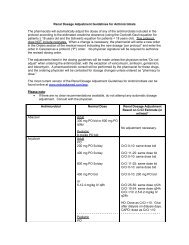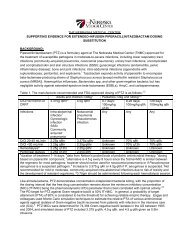Clostridium difficile Infection (CDI) - The Nebraska Medical Center
Clostridium difficile Infection (CDI) - The Nebraska Medical Center
Clostridium difficile Infection (CDI) - The Nebraska Medical Center
You also want an ePaper? Increase the reach of your titles
YUMPU automatically turns print PDFs into web optimized ePapers that Google loves.
Update on the Testing, Treatment, and Isolation of Patients with <strong>Clostridium</strong> <strong>difficile</strong> <strong>Infection</strong> (<strong>CDI</strong>)By Trevor Van Schooneveld, MD<strong>Clostridium</strong> <strong>difficile</strong>, the leading cause of nosocomial enteric infection, is a gram-positive, spore-forminganaerobe. <strong>CDI</strong> can develop if the normal gastrointestinal flora is disrupted by antibiotic therapy and aperson acquires toxin-producing C. <strong>difficile</strong>, typically via the fecal-oral route. Almost every antibiotic hasbeen associated with <strong>CDI</strong>, and the use of antibiotics is the major risk factor for <strong>CDI</strong>. <strong>The</strong> incidence,severity and mortality due to <strong>CDI</strong> have been steadily increasing over the last decade. This is likely due tothe spread of a new strain of C. <strong>difficile</strong> termed the NAP1/B1/O27 strain, which produces much higherlevels of toxin than previous strains and is resistant to fluoroquinolone antibiotics. This strain has beendetected at <strong>The</strong> <strong>Nebraska</strong> <strong>Medical</strong> <strong>Center</strong>, but the overall prevalence at <strong>The</strong> <strong>Nebraska</strong> <strong>Medical</strong> <strong>Center</strong> isunknown.<strong>The</strong> diagnosis of <strong>CDI</strong> has been difficult in the past as the most commonly used test, the toxin enzymeimmunoassay (EIA), has suboptimal sensitivity (70-90%). Clinicians have attempted to overcome thispoor sensitivity by repeat testing. Other tests are available for <strong>CDI</strong> such as culture, cytotoxic assay, testsfor a “common antigen” called glutamate dehydrogenase (GDH), and polymerase chain reaction (PCR)tests. In July of 2009, <strong>The</strong> <strong>Nebraska</strong> <strong>Medical</strong> <strong>Center</strong> introduced a new testing method for the detectionof <strong>CDI</strong> utilizing detection of both GDH and toxins A and B.Recommendations of how best to utilize this new assay were published by the institution, and the use ofthe new assay was analyzed over a 2-month period. <strong>The</strong> findings of this review suggested that repeatedtesting of stools for <strong>CDI</strong> was frequent, and the yield of repeat testing was quite low. Of 147 episodes ofrepeat testing of initially negative stools, only 2 patients (1.4%) were subsequently identified as havingpositive toxin assays, and patient charges were roughly $37,000 per positive toxin assay. It is unknown ifeither of these 2 patients actually had <strong>CDI</strong> as the likelihood of a false positive test result increasesdramatically with each repeated test due to lower pretest probability in the test population. Repeattesting typically results in more false positives than true positives.Based on the above data and a review of the literature, institutional guidelines have been developed bythe Antimicrobial Stewardship Program and Department of Healthcare Epidemiology regarding thetesting, treatment, and isolation of patients with <strong>CDI</strong>. Table 1 describes the interpretation of testresults.
hypotension, shock, toxic megacolon, and fulminant colitis. In cases with these complications both thegastroenterology and infectious disease service should be consulted and a regimen combining both oralvancomycin and intravenous metronidazole is recommended. Early colectomy can be life saving inpatients with severe disease. Little data exists to guide treatment in refractory disease. If <strong>CDI</strong> recursafter treatment, the same agent used to initially treat the infection should be used again for 10 days. Iffurther relapses occur, vancomycin should be used as prolonged courses of metronidazole have beenassociated with neurotoxicity.Isolation:Vigilant hand washing, isolation precautions, and environmental cleaning are keys to controlling C.<strong>difficile</strong>. All patient care areas will use the same procedures for testing, treatment and isolation.Universal glove use, the use of gowns for any substantial patient or environmental contact, and handhygiene with soap and water are key components to controlling the spread of C. <strong>difficile</strong>. Patients with anegative GDH and toxin assay do not need to be isolated. Patients with GDH positive, toxin negativestools may or may not have <strong>CDI</strong>. If patients have any symptoms consistent with <strong>CDI</strong> (i.e. diarrhea, fever,abdominal pain) they should remain in isolation as if they had a positive toxin assay. If patients with thisresult are completely asymptomatic (no diarrhea) then there is no need for isolation. Patients with <strong>CDI</strong>will remain in isolation for 1 week after treatment is completed and they are asymptomatic (nodiarrhea).For more information regarding any of these topics please refer to our recently revised guidelines andtreatment pathway at: www.nebraskamed.com/asp.Example Cases:Case #1: A 68 year-old male is admitted with community-acquired pneumonia. He is started onpiperacillin/tazobactam. On hospital day 2 he develops diarrhea. 3 stools are ordered and sent for C.<strong>difficile</strong> and all are negative for both GDH and toxin. Diarrhea resolves when piperacillin/tazobactam ischanged to ceftriaxone. Routine ordering of multiple C. <strong>difficile</strong> assays is unnecessary.Case #2: A 46 year-old female is admitted from home with diarrhea. Her only risk factor is receipt of asingle dose of prophylactic cefazolin 2 weeks ago during an orthopedic procedure. She has a stoolpositive for both GDH and toxin, is started on metronidazole, and improves. Any antibiotic can place aperson at risk for <strong>CDI</strong>.



